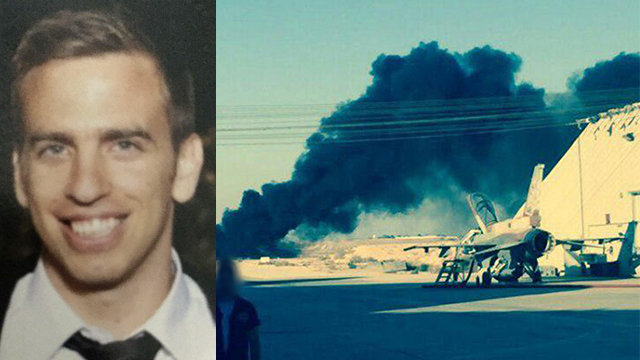
Initial investigation: crashed F-16 experienced 'asymmetrical' difficulties
Findings into the investigation surrounding circumstances of Capt. Ohad Cohen Nov’s death during a crash landing reveal weight asymmetry stemming from heat in one of the plane’s wings; ‘such a situation requires skill,’ says former F-16 pilot; possible ejection malfunction being investigated.
According to the investigation, the aircraft began experiencing technical difficulties upon its return from a reprisal airstrike attack in Gaza, leading Cohen Nov to fly another circle above the base prior to landing in an effort to remedy the problem. However, after it became clear that his efforts were insufficient, he took the decision to abandon the plane.
In accordance with the standard procedure and the automatic mechanisms in the ejection system, Cohen Nov’s navigator managed to eject from the plane, sustaining light injuries. The pilot’s ejection was supposed to occur seconds later but, for reasons which are yet to be fully determined, he did not manage to implement the ejection and at a critical moment the jet crashed before being engulfed with flames.
The preliminary investigation also indicates that the jet approached its landing in what is known as an ‘asymmetrical’ condition in which one side of the plane weighs more due to to heat which remains in one of the wings.
In addition, it is being checked whether a failure in the ejection system could have caused Cohen Nov’s death. The survival of the navigator will enable investigators better ascertain the cause of the incident.
According to witnesses from the Israel Air Force, Cohen Nov and the navigator took the required and appropriate measures under the circumstances of ‘asymmetry’ in the plane’s weight, and did so comprehensively.
In such a situation, the weight discrepancy can be as much as 2 tons. Such asymmetry is a well-known phenomenon among pilots which requires high levels of skill, particularly during landing. However, if investigators find that another malfunction contributed to the disaster—which has not yet been established—the difficulties involved in landing can be significantly exacerbated.
Moreover, ejection from the plane once the pilot has lost control in an an ‘asymmetrical’ situation also further increases the difficulties of implementing a successful ejection.
“Ejections via ejection seats usually work, but there is the central factor of a difference and asymmetry caused in operational flights: Returning when you have bombs on one side, and none on the other,” explained former F-16 pilot Col. Niri Yarkoni (res.) to Ynet. “The spectrum of the weight is massive and that is why flying the aircraft requires skill. The pilot can land in such a situation, but it isn’t something that they practice. Weight asymmetry occurs a lot. This model plane is considered to be extremely reliable.”
Asked whether an ejection malfunction could have occurred, Yarkoni responded. “It could have. It will be checked….Every slight delay can result in an unsuccessful ejection. Since both of the aircrew ejected, the back seat leaves first and then a few fractions of a second after the front one leaves. This is so that the rocket of the first one doesn’t burn the second person.”












